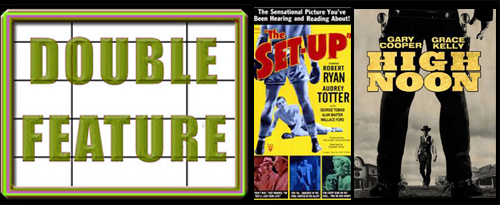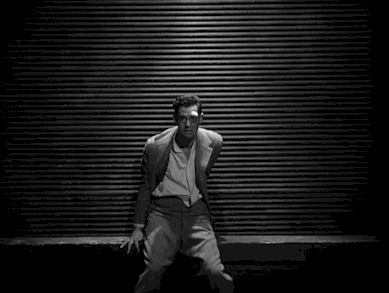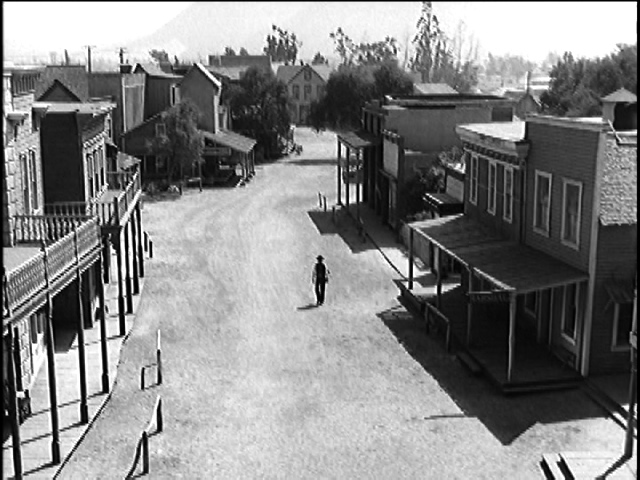
The double feature is cinema appreciation at its most basic. The mere act of pairing two films together – whether the bond be subject matter, central theme, a certain actor or filmmaker, or something outside-the-box conceptual – causes them to take on a different sort of life. A new relationship is formed with the viewer. You pay attention to new aspects and journey down unfamiliar avenues when you view films through Double Feature Goggles. Even when the linking bond is comically tenuous, the double feature magic is there. And I’m the kind of guy who derives just as much pleasure from creating a double feature as I do from watching one. Aside from amusing myself, hopefully I can give some people ideas for their next movie night.
Double Feature: The Set-Up (1949) and High Noon (1952).
The Connection: Many, both surface level and thematic. Both films are black and white. Both take place in roughly real-time, with a ticking clock of rapidly approaching doom. Most importantly, both films deal with a man on his way out, forced into a desperate situation where his friends forsake him; he must grapple with the price one pays for self-respect, and a hot blond wife who is unable to understand his motivations.
Film 1: From a writer’s perspective, The Set-Up‘s story is enviably simple…
Bill “Stoker” Thompson (The Wild Bunch‘s Robert Ryan) is a past his prime boxer, and no one knows this more intimately than his manager, Tiny (George Tobias). So confident is Tiny in Stoker’s losing streak, that he makes a deal with a local gangster for Stoker to throw a fight, and doesn’t even tell the boxer. “There’s no percentage in smartenin’ up a chump.” Stoker is sure to lose, and this way Tiny doesn’t need to cut the “chump” in on the dough. Meanwhile, Stoker’s wife Julie (Audrey Totter) doesn’t want him to show up for the fight. She is sure he’ll lose too. He always loses. And she loves him. Stoker barely survived his last fight, and she fears he’ll soon be punch drunk. She wants him to walkaway so they can settle down into a normal life. But Stoker has a feeling. He’s going to win this one. He’s got to do it. He’s a fighter! As things turn out, Stoker’s feeling was a good one. He gives the younger fighter he’s pitted against a run for his money. Tiny starts to get nervous, and eventually is forced to let Stoker in on the fix. If Stoker doesn’t take a dive, they’re all in big trouble. But Stoker won’t do it. He won’t go down.
The film is an adaptation of an epic poem by Joseph Moncure March (best known for another epic poem, The Wild Party, which inspired many writers of the Beat Generation). The film marked a turning point in the burgeoning career of director Robert Wise, who began his career as Orson Welles’ editor (on both Citizen Kane and The Magnificent Ambersons) before being given a chance in the director’s chair by legendary genre producer Val Lewton. The film is incredibly intimate, almost claustrophobic at times. The vast majority of the film takes place inside the rink’s locker room. Aside from the dexterity and realistic choreography of the climactic fight sequence, the film seems like it easily could have been a Playhouse 90 made-for-TV movie (that isn’t meant negatively).
Ryan gives a great performance as Stoker. Believably dim, with a kind heart, watching the man slowly swallowed by dramatic irony would be heartbreaking if it weren’t so tense. The film presents a very dismal view of the boxing world, where the boxers are just a commodity and no one really cares for them. Wise also presents the minutia of the boxing world with a high degree of plausibility, significantly ahead of its time (including the presence of an African-American boxer). The locker room is a spectrum of boxers, with a nervous noob vomiting before his match on one end, and the tragic “Gunboat” Johnson – terribly punch drunk and facially deformed from taking so many hits – on the other. Ryan does some nimble acting in these locker room scenes. As Stoker gives reassuring words to the noob, we can see that he is fondly remembering his own days as a noob, bright and full of potential. Conversely, when he talks with Gunboat, we know that Stoker realizes this is closer to his current position in the spectrum. This could be his future.

Film 2: Director Fred Zinnemann’s (From Here to Eternity) rare outing into the Western genre, High Noon also has an enviably simple story. Screenwriter Carl Foreman’s allegory about HUAC’s infamous communist witch hunts and the Hollywood Black List, tells the tale of Marshal Will Kane (Gary Cooper). Kane has just married Amy (most gorgeous woman ever, Grace Kelly), a Quaker. Kane has quit his job as Marshal, and he and Amy are just about to leave town when it is discovered that Frank Miller, a man Kane had sent to hang, has been pardoned and is arriving back in town on the noon train. Everyone, especially Amy, encourages Kane to leave before Miller returns to get his revenge, but with Kane’s replacement not yet in town, the Marshal feels it is his obligation to stay and keep the peace. Kane knows that there won’t be a problem if he can raise a posse of deputies to help him, but one by one his friends slink to the shadows and sidelines, too afraid to help. In the end, Kane is left to defend the town that has forsaken him by himself.
High Noon is a slightly overrated film. Don’t get me wrong, it’s a fucking great movie. But I think the ideas it presents are more iconic than much of its actual execution. I think its status as a masterpiece (often in the top 30 of greatest American films ever made lists) has a lot to do with the fact that it was somewhat maligned by Western fans upon its release. Where were the horse chases? Where was Monument Valley? Why is our hero begging people for help? The Duke would never beg anyone for help! (In fact, John Wayne hated this film. Though mainly because he was a conservative asshole and he didn’t like that it was speaking negatively of people who supported the Black List.) As a subversive underdog, it climbed its way to the top of the praise hill over time and its legend has only grown. Viewed all these decades later, the film is often too on-the-nose. But I digress, like I said, it is a great movie.
Unlike Robert Ryan, I have never understood the appeal of Gary Cooper. I just don’t find him convincing or compelling as an actor. And he is buried by a film full of excellent performances. Katy Jurado as Kane’s Mexican ex-lover gives the film’s most interesting and compelling performace. Lloyd Bridges, completely stripping himself of the inherent likability that would later make him a star, as Kane’s immature and conniving deputy. The Wolf Man himself, Lon Chaney, Jr., bringing his signature watery-eyed hangdog style to the key role of Kane’s former mentor; Chaney is actually High Noon‘s most crucial character, as his broken down ex-Marshal presents us with an antithesis reflection of noble Kane: “If you’re honest you’re poor your whole life and in the end you wind up dying all alone on some dirty street. For what? For nothing. For a tin star.” Then of course there is Grace Kelly, who is simply resplendent. And adorable. Despite my dislike of Cooper, Will Kane is a great character. It’s surprising that Western fans at the time did not like the character, as he reeks of ‘Old West’ grit. Kane’s predicament is a truly iconic one, and was highly influential. The “unHollywood” desperate, abandoned hero is now part of the fabric of movies; most notably in genre-switching quasi-remakes like the sci-fi thriller Outland and the high school comedy Three O’Clock High.

Double Feature Goggles: There are a lot of comparisons and contrasts to have fun with here. Cinematically the two films offer up a literal night and day contrast. Both films could be considered “uncinematic” in visual scope. Like The Set-Up, High Noon too feels like it could have been pulled off as a Playhouse 90 film with few compromises (likely something Ford and Hawkes fans of the time bitched about). But The Set-Up takes place entirely at night, in dark alleys and smoking rooms. High Noon is a daytime movie, with a good 50% of the film taking place outside in the stark sunlight. Visually they are complete opposites, effecting completely different moods. Yet both films play the same game: ticking clock tension.
What really bonds these films though is their examination of male dignity, or rather pride. Pride manifests itself differently in the respective films. For Stoker it isn’t so much that he is moralistically opposed to taking a dive (though he is), but that he knows he can win. This knowledge trumps all. He has come down a long road of failure, and this is it. It isn’t a suicide move, he isn’t trying to go out in a blaze of glory like Mickey Rourke in The Wrestler. This is philosophical. He simply can’t bring himself to lose – even when its in his best interest, physically and monetarily – when he knows he can win. He has to win. For Kane pride manifests itself in the form of duty. Why stay in the town when everyone is abandoning him and literally telling him, often begging him to go? Because he feels he has to. He is still Marshall until the new Marshal arrives. I don’t think Cooper does quite as good a job as Ryan in selling these motivations. Cooper’s typically flaccid performance can be taken as stern resolve, but at times it also has the problem of not fully selling Kane’s convictions, which has the bad side-effect of making Kane’s decision to stay feel more like ego than duty.
Both films also pit our heroes against that age-old enemy of male pride – an attractive wife who thinks her husband is acting like a dipshit. They’re the Marcellus Wallaces of the film, offering up the contrary perspective of “That’s pride fuckin’ with you.” The parallel is not a complete mirror for both women. The Set-Up‘s Julie is just as unaware of the fixed fight as Stoker is. Hers is a more reasonable request. She just wants Stoker to give up boxing, after having fruitlessly given twenty years of his life to the sport. The Quaker Amy is more directly opposing Kane’s pride, as she wants him to cut and run from an immediate conflict. But both women passive aggressively withdraw from their men. Julie, who has attended all of her husband’s fights, refuses to attend this match. Amy buys a ticket to leave town on the very train Frank Miller is arriving on. Both Stoker and Kane are noble heroes. They do not have arcs. It is in fact the two wives who are given arcs, slowly softening and coming around to support their men.
Both films also coolly and succinctly crystallize our heroes’ hard to word emotions and philosophical perspective in single lines to their wives. When pressed on his seemingly poor logic to attend his match, Stoker replies to Julie: “Well, that’s the way it is. You’re a fighter, you gotta fight.” High Noon offers up almost an identical line. When Amy presses Kane on why they must return to the town (having already safely escaped), all Kane can think to say is: “I’ve got to, that’s the whole thing.”